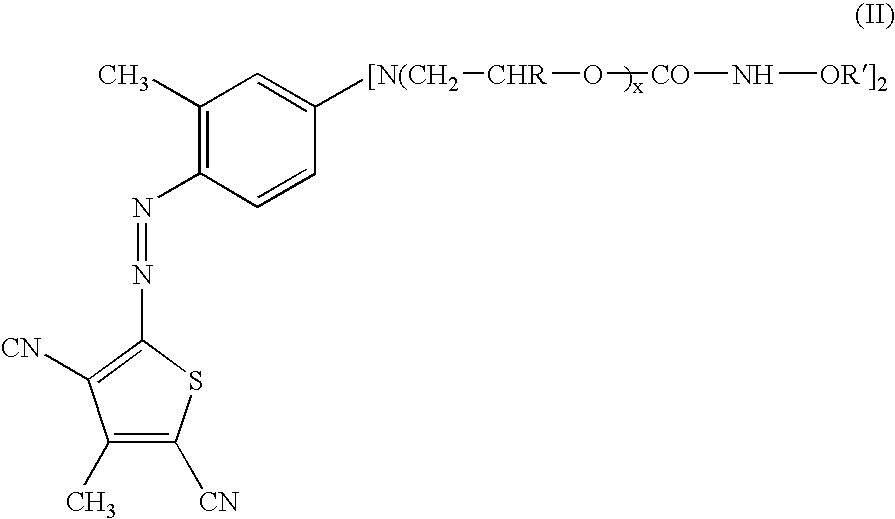Novel toner compounds and compositions for black offset inks
a technology of offset inks and compounds, applied in the field of new toner compounds and compositions for offset inks, can solve the problems of not providing teachings or fair suggestions of such needed improvements provided by and within offset ink pigments, and thereby simultaneously, and achieves the effect of achieving the desired look of printed images, excellent spectral strengths, and easy production
- Summary
- Abstract
- Description
- Claims
- Application Information
AI Technical Summary
Benefits of technology
Problems solved by technology
Method used
Image
Examples
example 1
[0036] 70 parts of a polymeric blue colorant, methylium, bis(4-aminophenyl)(4-aminophenyl)-, chloride, ethoxylated (.about.4-10 moles), propoxylated (.about.4-10 moles), having a Color Value of 65, were charged to a 3-neck flask. Added to this formulation were 80 parts of octadecylisocyanate, available from Aldrich, and 1.5 parts of dibutyltin dilaurate (catalyst). The entire mixture was then heated to 70-80.degree. C. for 2-6 hours or until the reaction is complete. The absence (disappearance) of a peak at about 2275 cm.sup.-1 (NCO) and the appearance (or increase in magnitude) of peaks at about 1740-1680 cm.sup.-1 and about 1540-1530 cm.sup.-1 corresponding to urethane frequencies was used to confirm this. The product had a color value of 29 at the .lambda..sub.max of 595.
example 2
[0037] 70 parts of the starting blue colorant from EXAMPLE 1, above, were charged to a 3-neck flask. Added to this formulation was 75 parts of octadecenyl isocyanate and 2.1 parts of TMXDI (diisocyanate), available from Aldrich, and 4 parts of dibutyltin dilaurate (catalyst). The entire mixture was then heated to 70-80.degree. C. for 2-6 hours or until the reaction is complete. The absence (disappearance) of a peak at about 2275 cm.sup.-1. (NCO) and the appearance (or increase in magnitude) of peaks at about 1740-1680 cm.sup.-1 and about 1540-1530 cm.sup.-1 corresponding to urethane frequencies was used to confirm this. The product had a color value of 28 at the .lambda..sub.max of 595.
example 3
[0038] 100 parts of a polymeric violet colorant, oxirane, methyl-, polymer with oxirane, ether (ethoxylated .about.2-10 moles, and propoxylated .about.4-14 moles) with 2,2'-((3-methyl-4-)(2-amino-4-methyl-3,5-dicyanot-hiophene)azo-phenyl-imino-bis)ethanol (2:1), having a Color Value of 28, was charged into a 3-neck flask. Added to this formulation was 40 parts of TMXDI (diisocyanate), available from Bayer, and 4 parts of dibutyltin dilaurate (catalyst). The entire mixture was then heated to 70-80.degree. C. for 2-6 hours or until all the hydroxyl groups reacted completely leaving an isocyanate terminated molecule. The absence (disappearance) of a peak at about 3600 cm.sup.-1 (OH) and the appearance (or increase in magnitude) of peaks at about 2275-2235 cm.sup.-1 corresponds to isocyanate frequencies was used to confirm this. Subsequently, 38 parts of octadecanol were charged to the flask and the reaction continued for 20 more hours at 70-80.degree. C. or until all of the isocyanate ...
PUM
| Property | Measurement | Unit |
|---|---|---|
| size | aaaaa | aaaaa |
| wavelengths | aaaaa | aaaaa |
| wavelengths | aaaaa | aaaaa |
Abstract
Description
Claims
Application Information
 Login to View More
Login to View More - R&D
- Intellectual Property
- Life Sciences
- Materials
- Tech Scout
- Unparalleled Data Quality
- Higher Quality Content
- 60% Fewer Hallucinations
Browse by: Latest US Patents, China's latest patents, Technical Efficacy Thesaurus, Application Domain, Technology Topic, Popular Technical Reports.
© 2025 PatSnap. All rights reserved.Legal|Privacy policy|Modern Slavery Act Transparency Statement|Sitemap|About US| Contact US: help@patsnap.com



